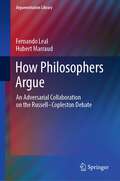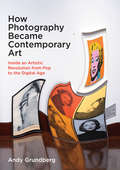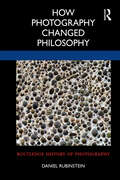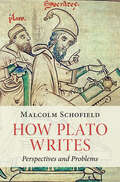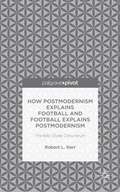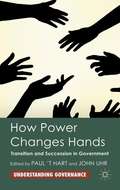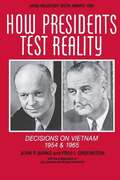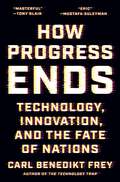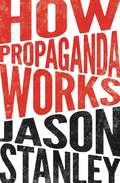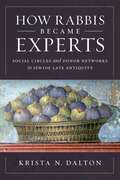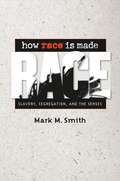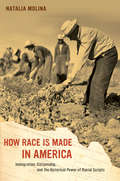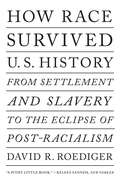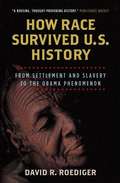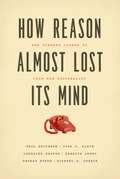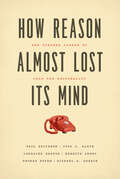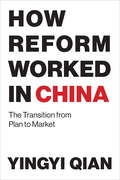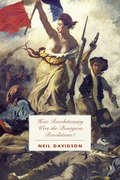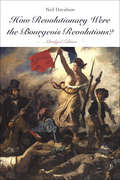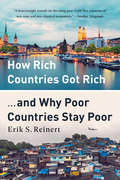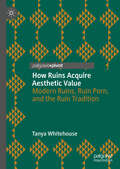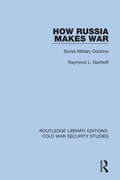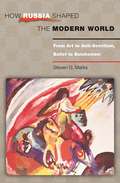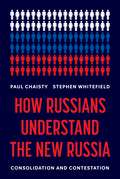- Table View
- List View
How Philosophers Argue: An Adversarial Collaboration on the Russell--Copleston Debate (Argumentation Library #41)
by Fernando Leal Hubert MarraudThis volume presents a double argumentative analysis of the debate between Bertrand Russell and Frederick Copleston on the existence of God. It includes an introduction justifying the choice of text and describing the historical and philosophical background of the debate. It also provides a transcript of the debate, based in part on the original recording.The argumentative analyses occupy Parts I and II of the book. In Part I the argumentative process is analysed by means of the ideal model of critical discussion, the workhorse of pragma-dialectics. Part I shows how the two parties go through the four stages of a critical discussion. It highlights the questions raised over and beyond the presiding question of whether God exists and examines almost a hundred questions that are raised. Many are left in the air, whereas a few others give rise to sundry sub-discussions or meta-dialogues. In Part II the theoretical framework of argument dialectic is put to work: argument structures are identified by means of punctuation marks, argumentative connectors and operators, allowing to see the argumentative exchange as the collaborative construction of a macro-argument. Such a macro-argument is both a joint product of the arguers and a complex structure representing the dialectical relationships between the individual arguments combined in it. Finally, the complementarity of the two approaches is addressed. Thus the book can be described as an exercise in adversarial collaboration.
How Photography Became Contemporary Art: Inside an Artistic Revolution from Pop to the Digital Age
by Andy GrundbergA leading critic&’s inside story of &“the photo boom&” during the crucial decades of the 1970s and 80s When Andy Grundberg landed in New York in the early 1970s as a budding writer, photography was at the margins of the contemporary art world. By 1991, when he left his post as critic for the New York Times, photography was at the vital center of artistic debate. Grundberg writes eloquently and authoritatively about photography&’s &“boom years,&” chronicling the medium&’s increasing role within the most important art movements of the time, from Earth Art and Conceptual Art to performance and video. He also traces photography&’s embrace by museums and galleries, as well as its politicization in the culture wars of the 80s and 90s. Grundberg reflects on the landmark exhibitions that defined the moment and his encounters with the work of leading photographers—many of whom he knew personally—including Gordon Matta-Clark, Cindy Sherman, and Robert Mapplethorpe. He navigates crucial themes such as photography&’s relationship to theory as well as feminism and artists of color. Part memoir and part history, this perspective by one of the period&’s leading critics ultimately tells a larger story about the crucial decades of the 70s and 80s through the medium of photography.
How Photography Changed Philosophy (Routledge History of Photography)
by Daniel RubinsteinBy analysing the philosophical lineage of notions of representation, time, being, light, exposure, image, and truth, this book argues that photography is the visual manifestation of the philosophical account of how humans encounter beings in the present. Daniel Rubinstein argues that traditional understandings of photography are determined by the notions of verisimilitude and representation, and this limits our understanding of photographic materiality. It is suggested that the photographic image must be closely read not for the objects, events and situations represented in it, but for the insights it affords into the structure of contemporary consciousness. The book will be of interest to scholars working in photography, media studies, philosophy, fine art, and art history.
How Plato Writes: Perspectives and Problems
by Malcolm SchofieldPlato is a philosophical writer of unusual and ingenious versatility. His works engage in argument but are also full of allegory, imagery, myth, paradox and intertextuality. He astutely characterises the participants whom he portrays in conversation. Sometimes he composes fictive dialogues in dramatic form while at other times he does so as narratives. In this book, world-renowned scholar Malcolm Schofield illustrates the variety of the literary resources that Plato deploys to achieve his philosophical purposes. He draws key passages for discussion particularly, but not only, from Republic and the less well-known Laws and also shows how reconstructing the original historical context of a dialogue and of its assumed readership is essential to understanding Plato's approach. The book will open the eyes of readers of all levels of expertise to Plato's masterly ability as a writer and how an understanding of this is crucial if we are to appreciate his philosophy.
How Postmodernism Explains Football and Football Explains Postmodernism: The Billy Clyde Conundrum
by Robert KerrAmerican football and postmodernist theory are both objects of popular and scholarly interest that reveal remarkable sociological insights. Analysis of media-driven commercial football documents how narratives of sportsmanship/brutality, heroism/antiheroism, athleticism/self-indulgence, honor/chicanery, and chivalry/sexism compete and thrive.
How Power Changes Hands
by Paul ’t Hart John UhrHow can we strengthen the capacity of governments and parties to manage arrivals and departures at the top? Democracy requires reliable processes for the transfer of power from one generation of leaders to the next. This book introduces new analytical frameworks and presents the latest empirical evidence from comparative political research.
How Presidents Test Reality: Decisions on Vietnam, 1954 And 1965
by Fred I. Greenstein John P. BurkeThe authors are concerned with establishing whether policy alternatives were systematically and rigorously addressed when Eisenhower made his decision not to intervene in Vietnam in 1954 and Johnson made the opposite decision in 1965 (the intrinsic quality of the decisions themselves is not their focus). Sources include recently declassified records and interviews with participants.
How Progress Ends: Technology, Innovation, and the Fate of Nations
by Carl Benedikt FreyLonglisted for the Financial Times and Schroders Business Book of the Year AwardHow 1,000 years of global history show why technological and economic progress is often followed by stagnation and even collapseIn How Progress Ends, Carl Benedikt Frey challenges the conventional belief that economic and technological progress is inevitable. For most of human history, stagnation was the norm, and even today progress and prosperity in the world&’s largest, most advanced economies—the United States and China—have fallen short of expectations. To appreciate why we cannot depend on any AI-fueled great leap forward, Frey offers a remarkable and fascinating journey across the globe, spanning the past 1,000 years, to explain why some societies flourish and others fail in the wake of rapid technological change.By examining key historical moments—from the rise of the steam engine to the dawn of AI—Frey shows why technological shifts have shaped, and sometimes destabilized, entire civilizations. He explores why some leading technological powers of the past—such as Song China, the Dutch Republic, and Victorian Britain—ultimately lost their innovative edge, why some modern nations such as Japan had periods of rapid growth followed by stagnation, and why planned economies like the Soviet Union collapsed after brief surges of progress. Frey uncovers a recurring tension in history: while decentralization fosters the exploration of new technologies, bureaucracy is crucial for scaling them. When institutions fail to adapt to technological change, stagnation inevitably follows. Only by carefully balancing decentralization and bureaucracy can nations innovate and grow over the long term—findings that have worrying implications for the United States, Europe, China, and other economies today.Through a rich narrative that weaves together history, economics, and technology, How Progress Ends reveals that managing the future requires us to draw the right lessons from the past.
How Propaganda Works
by Jason StanleyOur democracy today is fraught with political campaigns, lobbyists, liberal media, and Fox News commentators, all using language to influence the way we think and reason about public issues. Even so, many of us believe that propaganda and manipulation aren't problems for us--not in the way they were for the totalitarian societies of the mid-twentieth century. In How Propaganda Works, Jason Stanley demonstrates that more attention needs to be paid. He examines how propaganda operates subtly, how it undermines democracy--particularly the ideals of democratic deliberation and equality--and how it has damaged democracies of the past.Focusing on the shortcomings of liberal democratic states, Stanley provides a historically grounded introduction to democratic political theory as a window into the misuse of democratic vocabulary for propaganda's selfish purposes. He lays out historical examples, such as the restructuring of the US public school system at the turn of the twentieth century, to explore how the language of democracy is sometimes used to mask an undemocratic reality. Drawing from a range of sources, including feminist theory, critical race theory, epistemology, formal semantics, educational theory, and social and cognitive psychology, he explains how the manipulative and hypocritical declaration of flawed beliefs and ideologies arises from and perpetuates inequalities in society, such as the racial injustices that commonly occur in the United States. How Propaganda Works shows that an understanding of propaganda and its mechanisms is essential for the preservation and protection of liberal democracies everywhere.
How Proudly They Wave: Flags of the Fifty States
by Rita D. HabanFrom the Book Jacket: Did you know that Alaska's state flag was designed by a 13-year-old boy, or that California's first flag was made from a lady's petticoat? Each state flag tells a story through its design, and some of the stories are very interesting. In this book, Rita Haban introduces you to the 50 state flags. She tells the stories of their origins and explains the historical meaning of each emblem. Clear, colorful, detailed illustrations, supplied by the Flag Research Center in Winchester, Massachusetts, show the flags of each state. This is a first book for Rita Haban. Her interest in history stems from her own childhood, when a seventh grade teacher sparked her students' interest by illustrating history lessons on the blackboard. Haban studied English at Ohio State University. A member of the Society for Children's Book Writers, Haban also writes short stories and poetry. Two of her poems were published in the Ohio poetry awards, The Best of 1983. She and her family live in Reynoldsburg, Ohio.
How Rabbis Became Experts: Social Circles and Donor Networks in Jewish Late Antiquity
by Krista N. DaltonHow rabbinic expertise was socially constructed, performed, and defended in Roman PalestineAt the turn of the common era, the Jewish communities of Roman Palestine saw the organization of a small group of literate Jewish men who devoted their lives to the interpretation and teaching of their sacred ancestral texts. In this groundbreaking study, Krista Dalton shows that these early rabbis were not an insular specialist group but embedded in a landscape of Jewish piety. Drawing on the writings of rabbis in Roman Palestine from the second through fifth centuries CE, Dalton illuminates the significance of social relationships in the production of rabbinic expertise. She traces the social interactions—everyday instances of mutual exchange, from dinner parties to tithes and patronages—that fostered the perception of rabbis as experts.Dalton shows how the knowledge derived from the rabbis&’ technical skills was validated and recognized by others. Rabbis socialized and noshed with neighbors and offered advice and legal favors to friends. In exchange for their expert judgments, they received invitations, donations, appointments, and recognition. She argues that their status as Torah experts did not arise by virtue of being scholars but from their ability to persuade others that their mobilization of Jewish cultural resources was beneficial. Dalton describes the relational processes that made rabbinic expertise possible as well as the accompanying tensions; social interactions shaped the rabbis&’ domain of knowledge while also imposing expectations of reciprocity that had to be managed. Dalton&’s authoritative analysis demonstrates that a focus on friendship and exchange provides a fuller understanding of how rabbis claimed and defended their distinct expertise.
How Race Is Made
by Mark M. SmithFor at least two centuries, argues Mark Smith, white southerners used all of their senses--not just their eyes--to construct racial difference and define race. His provocative analysis, extending from the colonial period to the mid-twentieth century, shows how whites of all classes used the artificial binary of "black" and "white" to justify slavery and erect the political, legal, and social structure of segregation.Based on painstaking research, How Race Is Made is a highly original, always frank, and often disturbing book. After enslaved Africans were initially brought to America, the offspring of black and white sexual relationships (consensual and forced) complicated the purely visual sense of racial typing. As mixed-race people became more and more common and as antebellum race-based slavery and then postbellum racial segregation became central to southern society, white southerners asserted that they could rely on their other senses--touch, smell, sound, and taste--to identify who was "white" and who was not. Sensory racial stereotypes were invented and irrational, but at every turn, Smith shows, these constructions of race, immune to logic, signified difference and perpetuated inequality.Smith argues that the history of southern race relations and the construction of racial difference on which that history is built cannot be understood fully on the basis of sight alone. In order to come to terms with the South's past and present, Smith says, we must explore the sensory dynamics underpinning the deeply emotional construction of race. How Race Is Made takes a bold step toward that understanding.For at least two centuries, argues Mark Smith, white southerners used all of their senses--not just their eyes--to construct racial difference and define race. His provocative analysis, extending from the colonial period to the mid-twentieth century, shows how whites of all classes used the artificial binary of "black" and "white" to justify slavery and erect the political, legal, and social structure of segregation.Based on painstaking research, How Race Is Made is a highly original, always frank, and often disturbing book. Sensory racial stereotypes were invented and irrational, but at every turn, Smith shows, these constructions of race, immune to logic, signified difference and perpetuated inequality. In order to come to terms with the South's past and present, Smith says, we must explore the sensory dynamics underpinning the deeply emotional construction of race. How Race Is Made takes a bold step toward that understanding.-->
How Race Is Made in America
by Natalia MolinaHow Race Is Made in America examines Mexican Americans--from 1924, when American law drastically reduced immigration into the United States, to 1965, when many quotas were abolished--to understand how broad themes of race and citizenship are constructed. These years shaped the emergence of what Natalia Molina describes as an immigration regime, which defined the racial categories that continue to influence perceptions in the United States about Mexican Americans, race, and ethnicity. Molina demonstrates that despite the multiplicity of influences that help shape our concept of race, common themes prevail. Examining legal, political, social, and cultural sources related to immigration, she advances the theory that our understanding of race is socially constructed in relational ways--that is, in correspondence to other groups. Molina introduces and explains her central theory, racial scripts, which highlights the ways in which the lives of racialized groups are linked across time and space and thereby affect one another. How Race Is Made in America also shows that these racial scripts are easily adopted and adapted to apply to different racial groups.
How Race Survived US History: From Settlement and Slavery to the Eclipse of Post-racialism
by David R. RoedigerAn absorbing chronicle of the role of race in US history, by the foremost historian of race and laborThe Obama era produced countless articles arguing that America’s race problems were over. The election of Donald Trump has proved those hasty pronouncements wrong. Race has always played a central role in US society and culture. Surveying a period from the late seventeenth century—the era in which W.E.B. Du Bois located the emergence of “whiteness”—through the American Revolution and the Civil War to the civil rights movement and the emergence of the American empire, How Race Survived US History reveals how race did far more than persist as an exception in a progressive national history. This masterful account shows how race has remained at the heart of American life well into the twenty-first century.
How Race Survived US History: From Settlement and Slavery to the Obama Phenomenon
by David R. RoedigerExplores how the idea of race was created and recreated in American history. From the late seventeenth century to the civil-rights movement and the emergence of the American empire, this book examines how race intersected all that was dynamic and progressive in US history, from democracy and economic development to migration and globalization.
How Reason Almost Lost Its Mind: The Strange Career of Cold War Rationality
by Paul Erickson Michael D. Gordin Lorraine Daston Judy L. Klein Rebecca Lemov Thomas SturmIn the United States at the height of the Cold War, roughly between the end of World War II and the early 1980s, a new project of redefining rationality commanded the attention of sharp minds, powerful politicians, wealthy foundations, and top military brass. Its home was the human sciences--psychology, sociology, political science, and economics, among others--and its participants enlisted in an intellectual campaign to figure out what rationality should mean and how it could be deployed. How Reason Almost Lost Its Mind brings to life the people--Herbert Simon, Oskar Morgenstern, Herman Kahn, Anatol Rapoport, Thomas Schelling, and many others--and places, including the RAND Corporation, the Center for Advanced Study in the Behavioral Sciences, the Cowles Commission for Research and Economics, and the Council on Foreign Relations, that played a key role in putting forth a "Cold War rationality. " Decision makers harnessed this picture of rationality--optimizing, formal, algorithmic, and mechanical--in their quest to understand phenomena as diverse as economic transactions, biological evolution, political elections, international relations, and military strategy. The authors chronicle and illuminate what it meant to be rational in the age of nuclear brinkmanship.
How Reason Almost Lost Its Mind: The Strange Career of Cold War Rationality
by Paul Erickson Michael D. Gordin Lorraine Daston Judy L. Klein Rebecca Lemov Thomas SturmIn the United States at the height of the Cold War, roughly between the end of World War II and the early 1980s, a new project of redefining rationality commanded the attention of sharp minds, powerful politicians, wealthy foundations, and top military brass. Its home was the human sciences—psychology, sociology, political science, and economics, among others—and its participants enlisted in an intellectual campaign to figure out what rationality should mean and how it could be deployed. How Reason Almost Lost Its Mind brings to life the people—Herbert Simon, Oskar Morgenstern, Herman Kahn, Anatol Rapoport, Thomas Schelling, and many others—and places, including the RAND Corporation, the Center for Advanced Study in the Behavioral Sciences, the Cowles Commission for Research and Economics, and the Council on Foreign Relations, that played a key role in putting forth a “Cold War rationality.” Decision makers harnessed this picture of rationality—optimizing, formal, algorithmic, and mechanical—in their quest to understand phenomena as diverse as economic transactions, biological evolution, political elections, international relations, and military strategy. The authors chronicle and illuminate what it meant to be rational in the age of nuclear brinkmanship.
How Reform Worked in China: The Transition from Plan to Market
by Yingyi QianA noted Chinese economist examines the mechanisms behind China's economic reforms, arguing that universal principles and specific implementations are equally important. As China has transformed itself from a centrally planned economy to a market economy, economists have tried to understand and interpret the success of Chinese reform. As the Chinese economist Yingyi Qian explains, there are two schools of thought on Chinese reform: the “School of Universal Principles,” which ascribes China's successful reform to the workings of the free market, and the “School of Chinese Characteristics,” which holds that China's reform is successful precisely because it did not follow the economics of the market but instead relied on the government. In this book, Qian offers a third perspective, taking certain elements from each school of thought but emphasizing not why reform worked but how it did. Economics is a science, but economic reform is applied science and engineering. To a practitioner, it is more useful to find a feasible reform path than the theoretically best way. The key to understanding how reform has worked in China, Qian argues, is to consider the way reform designs respond to initial historical conditions and contemporary constraints. Qian examines the role of “transitional institutions”—not “best practice institutions” but “incentive-compatible institutions”—in Chinese reform; the dual-track approach to market liberalization; the ownership of firms, viewed both theoretically and empirically; government decentralization, offering and testing hypotheses about its link to local economic development; and the specific historical conditions of China's regional-based central planning.
How Revolutionary Were the Bourgeois Revolutions?
by Neil Davidson“An impressive contribution both to the history of ideas and to political philosophy.” —Alasdair MacIntyre, author of After VirtueOnce of central importance to left historians and activists alike, recently the concept of the “bourgeois revolution” has come in for sustained criticism from both Marxists and conservatives. In this magisterial work, Neil Davidson offers theoretical and historical insights about the nature of revolutions. Through extensive research and comprehensive analysis, Davidson demonstrates that what’s at stake is far from a stale issue for the history books—understanding that these struggles of the past offer far-reaching lessons for today’s radicals.“A monumental work. Neil Davidson has given us what is easily the most comprehensive account yet of the ‘life and times’ of the concept of ‘bourgeois revolution’ [and] has also provided us with a refined set of theoretical tools for understanding the often complex interactions between political revolutions which overturn state institutions and social revolutions which involve a more thoroughgoing transformation of social relations.” —Colin Mooers, author of The Making of Bourgeois Europe“Davidson’s book is one of immense and impressive erudition. His knowledge of the history of Marxist theory and historiography is as detailed as it is comprehensive, and must be well-nigh unrivalled. The endless, complex debates that characterize the Marxist tradition are distilled with clarity and illumination.” —Times Literary Supplement“A brilliant and fascinating book, wide-ranging and lucidly written.” —Jairus Banaji, author of Theory as History
How Revolutionary Were the Bourgeois Revolutions? (Abridged Edition)
by Neil DavidsonAn abridged edition of the insightful work praised as “an impressive contribution both to the history of ideas and to political philosophy” (Alasdair MacIntyre, author of After Virtue).Once of central importance to left historians and activists alike, recently the concept of the “bourgeois revolution” has come in for sustained criticism from both Marxists and conservatives. In this abridged edition of his magisterial How Revolutionary Were the Bourgeois Revolutions? Neil Davidson expertly distills his theoretical and historical insights about the nature of revolutions, making them accessible for general readers.Through extensive research and comprehensive analysis, Davidson demonstrates that what’s at stake is far from a stale issue for the history books—understanding that these struggles of the past offer far reaching lessons for today’s radicals.
How Rich Countries Got Rich ... and Why Poor Countries Stay Poor
by Erik S. ReinertA maverick economist explains how protectionism makes nations rich, free trade keeps them poor---and how rich countries make sure to keep it that way.Throughout history, some combination of government intervention, protectionism, and strategic investment has driven successful development everywhere from Renaissance Italy to the modern Far East. Yet despite the demonstrable success of this approach, development economists largely ignore it and insist instead on the importance of free trade. Somehow, the thing that made rich nations rich supposedly won't work on poor countries anymore. Leading heterodox economist Erik Reinert's invigorating history of economic development shows how Western economies were founded on protectionism and state activism and only later promoted free trade, when it worked to their advantage. In the tug-of-war between the gospel of government intervention and free-market purists, the issue is not that one is more correct, but that the winning nation tends to favor whatever benefits them most. As Western countries begin to sense that the rules of the game they set were rigged, Reinert's classic book gains new urgency. His unique and edifying approach to the history of economic development is critical reading for anyone who wants to understand how we got here and what to do next, especially now that we aren't so sure we'll be the winners anymore.
How Ruins Acquire Aesthetic Value: Modern Ruins, Ruin Porn, and the Ruin Tradition
by Tanya WhitehouseThis book provides the first recent philosophical account of how ruins acquire aesthetic value. It draws on a variety of sources to explore modern ruins, the ruin tradition, and the phenomenon of “ruin porn.” It features an unusual and original combination of philosophical analysis, the author’s photography, and reviews of both new and historically influential case studies, including Richard Haag’s Gas Works Park, the ruins of Detroit, and remnants of the steel industry of Pennsylvania. Tanya Whitehouse shows how the users of ruins can become architects of a new order, transforming derelict sites into aesthetically significant places we should preserve.
How Russia Makes War: Soviet Military Doctrine (Routledge Library Editions: Cold War Security Studies #26)
by Raymond L. GarthoffThis book, first published in 1954, is a key analysis of the guiding policies, basic assumptions, fundamental principles and methods of the Red Army, in many respects the most powerful force in the Cold War. This analysis examines the strategy and tactics, weapons systems, training, discipline and political doctrine of the Red Army, as well as focusing on the political control of the USSR and its satellite states.
How Russia Shaped the Modern World: From Art to Anti-Semitism, Ballet to Bolshevism
by Steven G. MarksIn this sweeping history, Steven Marks tells the fascinating story of how Russian figures, ideas, and movements changed our world in dramatic but often unattributed ways. On Europe's periphery, Russia was an early modernizing nation whose troubles stimulated intellectuals to develop radical and utopian alternatives to Western models of modernity. These provocative ideas gave rise to cultural and political innovations that were exported and adopted worldwide. Wherever there was discontent with modern existence or traditional societies were undergoing transformation, anti-Western sentiments arose. Many people perceived the Russian soul as the antithesis of the capitalist, imperialist West and turned to Russian ideas for inspiration and even salvation. Steven Marks shows that in this turbulent atmosphere of the past century and a half, Russia's lines of influence were many and reached far. Russia gave the world new ways of writing novels. It launched cutting-edge trends in ballet, theater, and art that revolutionized contemporary cultural life. The Russian anarchist movement benignly shaped the rise of vegetarianism and environmentalism while also giving birth to the violent methods of modern terrorist organizations. Tolstoy's visions of nonviolent resistance inspired Gandhi and the U.S. Civil Rights movement at the same time that Russian anti-Semitic conspiracy theories intoxicated right-wing extremists the world over. And dictators from Mussolini and Hitler to Mao and Saddam Hussein learned from the experiments of the Soviet regime. Moving gracefully from Moscow and St. Petersburg to Beijing and Berlin, London and Luanda, Mexico and Mississippi, Marks takes us on an intellectual tour of the Russian exports that shaped the twentieth century. The result is a richly textured and stunningly original account of the extent to which Russia--as an idea and a producer of ideas--has contributed to the making of the modern world. Placing Russia in its global context, the book betters our understanding of the anti-Western strivings that have been such a prominent feature of recent history.
How Russians Understand the New Russia: Consolidation and Contestation
by Paul Chaisty Stephen WhitefieldThe issues that are the most and the least divisive in RussiaThe collapse of the Soviet Union in 1991 created a new Russia, with new territorial boundaries and new political and economic systems. The hybrid political economy that emerged incorporated commitments to markets and democracy that were undermined by the state&’s economic interventions and authoritarian restrictions.In this book, Paul Chaisty and Stephen Whitefield argue that the hybridity of the post-Soviet system provided a strong basis for the consolidation of Russian public opinion—and for the management of contestation so that it did not threaten the system itself. Drawing on almost thirty years of original public opinion research in Russia, Chaisty and Whitefield also find, however, that the territorial dimension of Russia&’s postcommunist transformation has disrupted public support for the hybrid political economy. In particular, they trace the reopening of system-level disagreement between system supporters and system opponents to the nationalist turn in Russian politics that culminated in the 2014 annexation of Crimea and the reactivation of Soviet identities.How Russians Understand the New Russia provides the first longitudinal study of Russian public opinion on the system of political and economic power that replaced communism. It offers unique insights into how Russian citizens have adapted their views of the new Russia, identifying the issues that are the most—and the least—divisive. Chaisty and Whitefield track Russian public opinion on a broad range of policy questions, discuss the political importance of both voting and not voting and consider problems of nation-building and national identity. Finally, they weigh the impact of the Ukraine war on Russia&’s hybrid system, and whether consolidation or further contestation is more likely.
